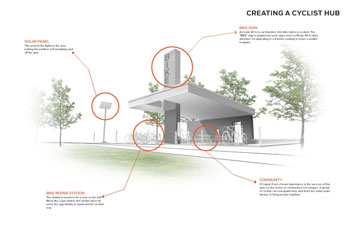Completed in 2017, Wilson Road Trailhead Park in Columbus, Ohio, earned a Merit Award (2018) from the American Institute of Architects (AIA) Columbus Chapter, as well as an Honor Award (2017) from the AIA Ohio Chapter. Designed by multidisciplinary design firm WSA, the $450,000 project was funded by the Columbus Recreation and Parks Department, which received funding help from the Westside Community Fund, provided by the Hollywood Casino. At the same time, the Ohio Department of Transportation was funding the development of the connecting bike trails.
“The Wilson Road Trailhead project uses a simple, timeless structure to mark place and establish a community hub that promotes healthy living,” said WSA President Timothy Hawk, FAIA. “It’s pretty remarkable how this small intervention has made such a difference in the Columbus Westgate community.”
One of the main goals for the site was to provide a place for the community to gather. “Parks connect people and neighborhoods, and we wanted to create an environment unique to the neighborhood that could support community and be a part of the neighborhood they could embrace,” explained Sam Cejda, communications director for WSA. “Another aim was to also increase the sense of safety and comfort through development of a public park. It was our and the city’s goal to reinforce the sense of community in the neighborhood, and the establishment of the park was geared toward spurring further public development to enrich the community experience.
“Additionally, there was a goal for the park to spur economic development and further revitalization. The park is a connecting point for the 15-mile-long Camp Chase Trail that leads into the network of greenways and bikeways in central Columbus. It is also a part of the Ohio to Erie Trail that runs 450 miles, connecting the Ohio River in Cincinnati to Lake Erie in Cleveland. Being a part of these extensive networks, we had hopes that the park would bring people to an often-bypassed neighborhood and connect residents of Westgate to the wider parks system.”
The new park features an open-air shelter with picnic tables, bike racks and a bike repair station, and provides cyclists traveling across the state a chance to rejuvenate while connecting the surrounding neighborhoods with a sense of community.
The community was invited to be part of the planning process, and the early planning stages included a series of programming meetings for residents. “This created an additional challenge in competing priorities,” Cejda said. “Those who saw the park as a hub along a greater bike trail network wanted resources to be put to enhance the function to cyclists. Residents of the local community were more concerned with the park’s function as a community space. With competing sets of priorities, the design team took care to make sure that all goals were met through efficient and innovative design.
“There was also a sustainability challenge. With an undeveloped space, how do we create a park with minimum environmental impact? That led us to a net-zero energy design. Solar panels power the area lighting, and a streamlined storm water management strategy empties water directly into a storm water retention swale that was designed into the natural landscape environment. To further tie our sustainability goals with our design goals we sourced many of the materials locally, including brick that was quarried in northeast Ohio.”
Since its opening, Wilson Road Park has had a big impact on the surrounding community. “From being the first park on this side of Columbus in 15 years, to a connecting point for statewide, regional, and local trails, impact can be seen in the traffic passing through, and in the consistent use of the park by locals and community groups,” Cejda said. “The park is helping Columbus progress toward transit equity. The Camp Chase Trail connects downtown Columbus to the West side of the city, and the park is vital to providing residents of these neighborhoods with safer bike commuting and public recreation space. The trailhead park not only represents impactful and practical design but creates the viability of safer commuting, advantages of greater public recreation space, and accessibility for all.” RM
FOR MORE INFORMATION
Columbus Recreation and Parks Department: columbusrecparks.com
WSA: wsastudio.com


